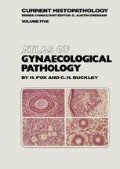Abstract
The Fallopian tube extends from the ostium laterally to the uterine cornu medially and comprises four sections, the infundibulum, into which the ostium opens, the ampulla, which is the longest section, the isthmus and the interstitial part which lies within the uterine musculature. The wall is formed by an inner mucosa, an intermediate muscular layer and a serosal covering. The mucosa is thrown into a series of folds or plicae which are simple and few in the medial portion of the tube, but more complex and numerous laterally. The muscular wall comprises a well-defined inner, circular layer and a filamentous, ill-defined, outer longitudinal layer. A second longitudinal layer lies deep to the circular muscle in the interstitial and proximal parts of the tube where its filaments extend into the mucosal folds. The tubal ostium is surrounded by a series of finger-like projections, the fimbria, and it is not unusual to see vestigial, non-communicating accessory ostia adjacent to the definitive ostium. Walthard’s rests, which appear as sago-like granules on the tubal serosa, are so common as to be regarded as normal.
Access this chapter
Tax calculation will be finalised at checkout
Purchases are for personal use only
Preview
Unable to display preview. Download preview PDF.
References
Pauerstein, C. J. (1974). The Fallopian Tube: A Reappraisal. ( Philadelphia: Lea and Febiger )
Bernhardt-Huth, D., Frantzen, Ch. and Schlösser, H. W. (1979). Morphological alterations of rabbit oviducts following ligature of the tubal isthmus. Virch. Arch. Pathol. Anat. Histol., 384, 195–211
Vasquez, G., Winston, R. M. L., Boeckx, W. and Brosens, I. (1980). Tubal lesions subsequent to sterilisation and their relation to fertility after attempts at reversal. Am. J. Obstet. Gynecol., 138, 86–92
Honoré, L. H. (1978). Salpingitis isthmica nodosa in female infertility and ectopic pregnancy. Fertil. Steril., 29, 164–168
Author information
Authors and Affiliations
Rights and permissions
Copyright information
© 1983 H. Fox and C. H. Buckley
About this chapter
Cite this chapter
Fox, H., Buckley, C.H. (1983). Fallopian Tube and Broad Ligament:Non—Neoplastic Conditions. In: Atlas of Gynaecological Pathology. Current Histopathology, vol 5. Springer, Dordrecht. https://doi.org/10.1007/978-94-015-7312-2_19
Download citation
DOI: https://doi.org/10.1007/978-94-015-7312-2_19
Publisher Name: Springer, Dordrecht
Print ISBN: 978-94-015-7314-6
Online ISBN: 978-94-015-7312-2
eBook Packages: Springer Book Archive

